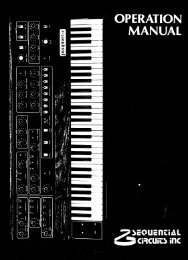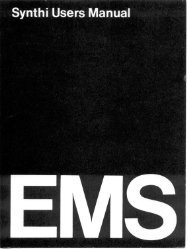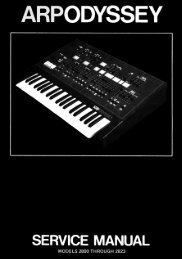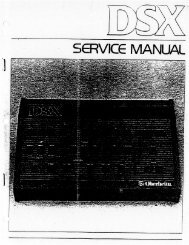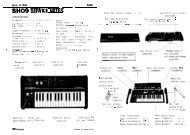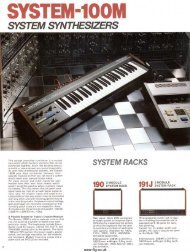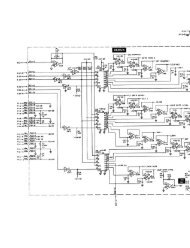ARP2600 - Fundamentals of Music Technology - Cyborgstudio.com
ARP2600 - Fundamentals of Music Technology - Cyborgstudio.com
ARP2600 - Fundamentals of Music Technology - Cyborgstudio.com
Create successful ePaper yourself
Turn your PDF publications into a flip-book with our unique Google optimized e-Paper software.
SECTION FIVE: NOISE GENERATOR - 037Pink noise is much like white noise, but has fewer high frequencies, and thus has a duller sound. Thefrequencies are removed with a device called a filter. Filters will be discussed in great detail in Section6. For now, it is only important to understand that the filter on the noise generator can attenuate theamount <strong>of</strong> high frequencies the noise generator actually produces. When the noise generator’s frequencyslider is set at LOW FREQ, only low frequencies are produced (low frequency noise), and thenoise generator makes a rather low, rumbling sound not unlike a waterfall heard from a distance.<strong>Music</strong>ians sometimes refer to other colors, such as blue noise, red noise, and even green noise, butthese are all for rather specialized purposes, and it is unnecessary to understand them <strong>com</strong>pletely at thistime. It is just important to realize that they exist.THE NOISE GENERATOR IN FMThe noise generator has hundreds <strong>of</strong> potential uses, but only a few <strong>of</strong> them are available to the studentat this time, since the only modules that have been studied are the oscillators. It is possible, however, touse noise to modulate the frequency <strong>of</strong> an oscillator as the patch in Figure 5-2 shows.Noise GeneratorFreq LevelOutputFM InputVCO-3SawWaveOutputNFigure 5-2: The noise generator in FMTo amplifierand speakersThe noise generator’soutput has been patchedto an FM input on VCO-3. (VCO-3 is a goodchoice as the noise generatoris already normalledto one <strong>of</strong> its FMinputs. Notice that alarge ‘N’ has been drawnon the line representingthe patch cord to indicatethat this patch is a normal.)VCO-3 is the carrierin this patch, whilethe noise generator is the modulator. (Remember that the noise generator can’t be modulated, so this isthe only possibility.) The volume <strong>of</strong> the noise generator has been set all the way up, and it is set toproduce white noise. Generally, the noise generator’s level will be set full open, and then its level willbe attenuated at the inputs <strong>of</strong> the various carriers where it arrives. This is the best strategy, since thenoise generator’s level can always be attenuated at any given input, but it can’t be amplified. Thevolume control on the output <strong>of</strong> this module is something <strong>of</strong> a fluke on the 2600. The noise generator isthe only module on the 2600 which allows the user to set an output volume.The depth <strong>of</strong> modulation in Figure 5-2 is not set too high as too much frequency modulation by thenoise generator will easily cause a <strong>com</strong>plete loss <strong>of</strong> tone. This sort <strong>of</strong> frequency modulation producesrather interesting sounds which tend to be more organic and grungy and lack the sterile, boring quality<strong>of</strong> pure waveforms. Some FM patches created with the noise generator can be heard on CD track 16.




